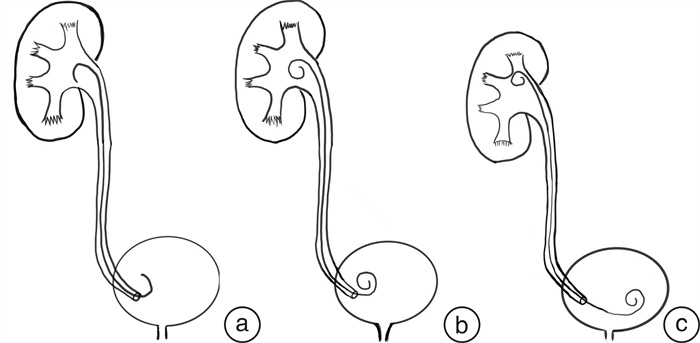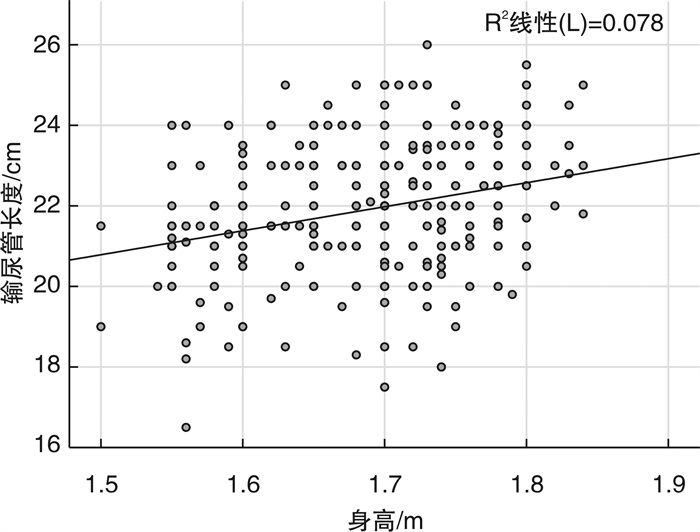Intraoperative ureteroscopy measurement in choosing ideal length of double J stent for endourologic surgery
-
摘要: 目的 探讨输尿管镜体术中直接测量输尿管长度指导上尿路术后留置理想双J管的临床疗效及安全性。方法 选择潍坊市中医院2019年1月—2022年6月因上尿路结石接受双J管留置的患者300例,其中276例患者完成随访,24例患者因记录不全或失访退出。其中男200例(72.5%),女76例(27.5%); 年龄20~90岁,平均(48.39±13.16)岁; 体重42~125 kg,中位体重72 kg; 左侧149例(54.0%)、右侧127例(46.0%)。根据术中输尿管镜体测量法选择与输尿管长度最接近的双J管,术后第1天和拔管前分别行KUB检查。留置双J管前和拔管前分别完成输尿管支架相关症状问卷(Ureteral Stent Related Symptoms Questionnaire,USSQ),包括下尿路症状(lower urinary tract symptom,LUTS)、疼痛评分、血尿评分以及整体健康状况评估等。根据身高分组比较不同组间输尿管支架管相关并发症的差异。结果 本组患者身高为150~184 cm,平均(168.00±0.77) cm; 术中输尿管镜体法测量输尿管长度范围为16.50~26.00 cm,平均(21.89±1.64) cm,其中左侧输尿管平均长度(22.13±1.67) cm,右侧输尿管平均长度(21.61±1.58) cm。留置22 cm双J管183例(66.3%),24 cm双J管79例(28.6%),26 cm双J管14例(5.1%); b型输尿管支架190例(68.8%),5例(1.8%)出现输尿管支架移位。225例(81.5%)术后出现轻度肉眼血尿,105例(38.0%)夜尿≥2次,79例(28.6%)自述有尿急症状。通过患者身高分组比较USSQ及位置良好型输尿管支架差异无统计学意义(P>0.05)。结论 术中输尿管镜测量法指导选择理想双J管简单、准确、安全有效。22~24 cm长度输尿管支架管可能更适合于身高 < 180 cm的大多数中国患者。Abstract: Objective To explore intraoperative ureteroscopy measurement in the determination of ideal double J stent length for endourologic surgery to reduce the postoperative ureteral stent related symptoms.Methods Data of 276 patients who accepted double-J ureteral stent indwelling because of upper urinary tract stone or ureteral stricture in Weifang Hospital of Traditional Chinese Medicine from January 2019 to June 2022 were collected. The body height ranged from 150 to 184 cm(mean 168.00±0.77 cm). The age of patients ranged from 20 to 90 yrs (mean 48.39±13.16 yrs). The weight ranged from 42 to 125 kg (mean 72 kg). This study included 200 males(72.5%) and 76 females(27.5%), left side in 149(54.0%)cases and right side in 127(46.0%) cases. The closest double-J ureteral stent was selected according to the measured length, then KUB was performed on the first day after operation and before extubation to understand the position of double-J ureteral stent. The Ureteral Stent Related Symptoms Questionnaire (USSQ), including lower urinary tract symptoms (LUTS), physical pain symptoms, hematuria score, and overall health status were completed before tube placing and extubation respectively. According to the height group, the differences of double J ureteral stent indwelling guided by ureteroscopic measurement among different height groups were further compared.Results The length of ureter measured by ureteroscope during operation was 16.50-26.00 cm (average 21.89±1.64). The average length of left ureter was (22.13±1.67) cm, and the right ureter was (21.61±1.58) cm. Length of 22 cm stents were placed for 183 cases (66.3%), 24 cm for 79 cases (28.6%), and 26 cm stents for 14 cases (5.1%). Five cases (1.8%) had ureteral stent displacement, 225 cases (81.5%) had gross hematuria, and 105 cases (38.0%) had nocturia for more than 2 times, 79 cases (28.6%) described symptoms of urinary urgency, and 190 cases (68.8%) were placed with type b ureteral stent. There was no significant difference between USSQ and b-type ureteral stents in height grouping (P>0.05), so ureteroscopy to guide double-J tube indwelling is suitable for each height segment.Conclusion Selecting the length of the double-J ureteral stent with the guidance of intraoperative ureteroscopy can provide a simple and accurate method for indwelling a suitable length of the double J ureteral stent after upper urinary tract surgery. Length of 22-24 cm ureteral stent may be suitable for most Chinese patients with height < 180 cm.
-

-
表 1 按身高分组比较不同身高患者带管相关症状
例(%),X±S,M(P25,P75) 项目 患者身高 <160 cm(62例) 160~170 cm(104例) >170~180 cm(90例) >180 cm(20例) P值 男/女 9/53 81/23 90/0 20/0 < 0.01 平均身高/cm 157.00±0.24 167.00±0.28 178.00±0.03 181.00±0.02 < 0.01 左/右 30/32 56/48 49/41 6/14 0.216 年龄/岁 53.74±12.40 50.72±13.03 45.12±11.81 38.10±13.15 0.014 体重/kg 60.75(55.75,66.50) 70.00(64.25,75.75) 75.00(70.00,81.75) 75.00(70.00,84.25) < 0.01 体重指数/(kg/m2) 24.94(22.89,26.69) 25.24(22.80,27.41) 25.08(23.51,26.83) 25.35(23.66,26.83) < 0.01 平均输尿管长度/cm 21.22±1.53 21.77±1.54 22.19±1.72 23.12±1.36 < 0.01 输尿管长度范围/cm 16.5~24.0 17.5~25 18.0~26.0 20.5~25.5 支架管长度 < 0.01 22 cm 52(83.9) 75(72.1) 49(54.4) 7(35.0) 24 cm 10(16.1) 24(23.1) 35(38.9) 10(50.0) 26 cm 0(0) 5(4.8) 6(6.7) 3(15.0) 输尿管支架移位 2(3.2) 1(1.0) 2(2.2) 0(0) 0.200 夜尿/分 1(1,2) 1(1,2) 1(1,2) 1(1,1) 0.093 尿急/分 1(1,2) 1(1,2) 1(1,2) 1(1,2) 0.885 血尿/分 2(2,2) 2(2,2) 2(2,2) 2(2,2) 0.956 总体健康评分/分 10(9,12) 10(9,12) 10(9,12.75) 10(9,10) 0.869 泌尿系症状总评分/分 14.71±4.04 14.78±2.98 14.84±3.89 13.20±1.36 0.833 疼痛视觉模拟评分/分 1(0,2) 1(0,2) 1(0,2) 0.5(0,1.75) 0.473 b型双J管留置 41(66.1) 77(74.0) 60(66.7) 12(60.0) 0.213 -
[1] Joshi HB, Stainthorpe A, MacDonagh RP, et al. Indwelling ureteral stents: evaluation of symptoms, quality of life and utility[J]. J Urol, 2003, 169(3): 1065-1069;discussion 1069. doi: 10.1097/01.ju.0000048980.33855.90
[2] Joshi HB, Okeke A, Newns N, et al. Characterization of urinary symptoms in patients with ureteral stents[J]. Urology, 2002, 59(4): 511-516. doi: 10.1016/S0090-4295(01)01644-2
[3] Inn FX, Ahmed N, Hou LG, et al. Intravesical stent position as a predictor of quality of life in patients with indwelling ureteral stent[J]. Int Urol Nephrol, 2019, 51(11): 1949-1953. doi: 10.1007/s11255-019-02262-7
[4] Taguchi M, Yasuda K, Kinoshita H. Prospective randomized controlled trial comparing a ureteral stent crossing versus not crossing the bladder midline[J]. World J Urol, 2022, 40(6): 1537-1543. doi: 10.1007/s00345-022-03978-5
[5] Mehra K, Manikandan R, Dorairajan LN, et al. Effect of Ureteral Stent Length and Position of Stent Coil in Bladder on Stent-Related Symptoms and Quality of Life of Patients[J]. Cureus, 2020, 12(11): e11669.
[6] Lee SJ, Yoo C, Oh CY, et al. Stent Position Is More Important than α-Blockers or Anticholinergics for Stent-Related Lower Urinary Tract Symptoms after Ureteroscopic Ureterolithotomy: A Prospective Randomized Study[J]. Korean J Urol, 2010, 51(9): 636-641. doi: 10.4111/kju.2010.51.9.636
[7] Jeon SS, Choi YS, Hong JH. Determination of ideal stent length for endourologic surgery[J]. J Endourol, 2007, 21(8): 906-910. doi: 10.1089/end.2006.0476
[8] Paick SH, Park HK, Byun SS, et al. Direct ureteric length measurement from intravenous pyelography: does height represent ureteric length?[J]. Urol Res, 2005, 33(3): 199-202. doi: 10.1007/s00240-004-0461-3
[9] Ho CH, Huang KH, Chen SC, et al. Choosing the ideal length of a double-pigtail ureteral stent according to body height: study based on a Chinese population[J]. Urol Int, 2009, 83(1): 70-74. doi: 10.1159/000224872
[10] Pilcher JM, Patel U. Choosing the correct length of ureteric stent: a formula based on the patient's height compared with direct ureteric measurement[J]. Clin Radiol, 2002, 57(1): 59-62. doi: 10.1053/crad.2001.0737
[11] Taguchi M, Yoshida K, Sugi M, et al. Simplified method using kidney /ureter/bladder x-ray to determine the appropriate length of ureteral stents[J]. Int Braz J Urol, 2018, 44(6): 1224-1233. doi: 10.1590/s1677-5538.ibju.2017.0620
[12] Barrett K, Foell K, Lantz A, et al. Best Stent Length Predicted by Simple CT Measurement Rather than Patient Height[J]. J Endourol, 2016, 30(9): 1029-1032. doi: 10.1089/end.2016.0105
[13] Hwang I, Kim SO, Yu HS, et al. A preliminary study of the variability in location of the ureteral orifices with bladder filling by fluoroscopic guidance: the gender difference[J]. Int Urol Nephrol, 2013, 45(3): 639-643. doi: 10.1007/s11255-013-0463-6
[14] Kawahara T, Ito H, Terao H, et al. Which is the best method to estimate the actual ureteral length in patients undergoing ureteral stent placement?[J]. Int J Urol, 2012, 19(7): 634-638. doi: 10.1111/j.1442-2042.2012.02998.x
[15] Shah J, Kulkarni RP. Height does not predict ureteric length[J]. Clin Radiol, 2005, 60(7): 812-814. doi: 10.1016/j.crad.2004.08.018
[16] 王永传, 毕玉行, 任安吉, 等. 不同输尿管长度测量法在双J管留置中的应用[J]. 现代泌尿外科杂志, 2023, 28(2): 5. https://www.cnki.com.cn/Article/CJFDTOTAL-MNWK202302004.htm
[17] Sali GM, Joshi HB. Ureteric stents: Overview of current clinical applications and economic implications[J]. Int J Urol, 2020, 27(1): 7-15. doi: 10.1111/iju.14119
[18] Jung SI, Park HS, Yu MH, et al. Korean ureter length: A computed tomography-based study[J]. Investig Clin Urol, 2020, 61(3): 291-296. doi: 10.4111/icu.2020.61.3.291
[19] Lee BK, Paick SH, Park HK, et al. Is a 22 cm Ureteric Stent Appropriate for Korean Patients Smaller than 175 cm in Height?[J]. Korean J Urol, 2010, 51(9): 642-646. doi: 10.4111/kju.2010.51.9.642
-





 下载:
下载:
